Resource-Oriented Treatment Technologies for Rural Domestic Sewage in China Amidst Population Shrinkage: A Case Study of Heyang County in Guanzhong Region, Shaanxi Province
Abstract
1. Introduction
2. Literature Review
3. Materials and Methods
3.1. Study Area
3.2. Data Collection
3.3. Methods
- (1)
- Theoretical Framework Development
- (2)
- Field Investigation and Data Acquisition
- (3)
- Data Analysis and Technical Solution Formulation
4. Results
4.1. Impact of Population Shrinkage on Rural Sewage Management
- (1)
- The LR < 40% (average 32.7%) for 75.5% of the facilities.
- (2)
- The average CD is 218%.
4.2. Resource-Oriented Treatment Technology Based on the “Source–Transmission–Sink” Process
4.2.1. Source Process Reduction Technology
- Q: Daily treatment capacity (m3/d);
- q: Per capita domestic sewage discharge (L/d);
- p: Permanent population (persons);
- r: Effective sewage collection rate (%);
- k: Daily variation coefficient;
- Qe: Daily dissipated wastewater volume from upper-level systems (m3/d).
4.2.2. Transmission Process Interception and Control Technology
4.2.3. Sink Process Attenuation Technology
4.3. Comprehensive Benefit Analysis
5. Discussion
- (1)
- Advantages: In the source process reduction technology, different from Germany’s high-cost vacuum collection system and Japan’s decentralized model relying on household-level purification tanks, the STS framework integrates agricultural techniques through sewage irrigation for agricultural use. While realizing the resource utilization of nitrogen and phosphorus, it reduces the construction cost by 40–60%. In the transmission process interception technology, the mixed ecological ditch (a combination of biofilm carriers and wetland plants) can achieve a COD interception rate of 65% at a cost of USD 12 per meter, which is 33% lower than South Korea’s compact wetland system (with a cost of USD 18 per meter), and the maintenance complexity is only 50% of that of Australia’s septic tank–oxidation pond combination [22]. In the sink process attenuation technology, the collaboration between the artificial wetlands in the village area and the reuse of cultivated land achieves a water resource recovery rate of 90%, which is significantly better than the independent decentralized units in the United States (with a recovery rate of 70–75%) and the independent wetland systems [24], confirming the theoretical advantages of the “production–ecological” spatial nesting.
- (2)
- Limitations: Compared with Japan’s intelligent purification tanks and the Internet of Things monitoring system in the United States, the STS system has a relatively low level of automation, and manual inspections are required in remote villages. Due to the simplified filler configuration, the total phosphorus removal efficiency (60–70%) is lower than that of Germany’s PKA wetlands (85–90%), especially in the loess percolation area, which is easily affected by soil compaction.
- (3)
- The limitations of this study include the limited representativeness of the samples (a single-case study of Heyang County), which may affect the generalizability of the conclusions. In the future, the verification of this technology’s popularity will be expanded in typical scenarios. At the same time, the successful implementation of the technology requires collaborative innovation in policy frameworks, technical standards, and governance mechanisms. It is recommended that the government accelerate the formulation of operable planning guidelines to promote the application of resource-oriented treatment technologies.
6. Conclusions
- (1)
- Adaptability mismatch of infrastructure: There is significant design redundancy in centralized systems (with an average capacity deviation of 218%). Of the facilities, 75.5% have a load rate of less than 40%, and for every 10% increase in the PSI, the risk of facility failure rises by 48.7%. Compared with the high-cost model of centralized collection and treatment, the STS system can reduce ineffective investment by more than 60% through dynamic capacity adjustment, verifying the urgency of the transformation from static planning to an adaptive model.
- (2)
- Circular benefits of promoting treatment through utilization: The STS framework achieves a water reuse rate of 85% and a nutrient recovery rate of 65% through the “sewage–fertilizer source–farmland” circular chain. It reduces treatment costs by 40–60% compared with the centralized collection and treatment model. Meanwhile, with a resident acceptance rate of 78%, it reshapes traditional farming wisdom and provides a Chinese path for SDG 6 and SDG 12.
- (3)
- Spatial optimization efficiency: The hierarchical GWI network reduces transportation costs by 30–45% through near-source treatment (with a service radius of ≤300 m). Its “household–village” collaborative mode improves spatial efficiency compared with the independent unit system, providing a scalable criterion for territorial space planning.
- (1)
- Establish a population-responsive funding mechanism and give priority to supporting shrinking villages in the national ecological compensation plan.
- (2)
- Formulate adaptive technical standards. Set differentiated treatment thresholds according to the classification of “stable-transition–acutely shrinking” villages. Pilot the STS technology package in areas with population shrinkage and provide a guide for the rapid deployment of modular GWI.
- (3)
- Build a cross-departmental governance platform. Incorporate sewage resource utilization into the assessment of the balance between cultivated land occupation and compensation. Establish a three-party operation and maintenance platform for “farmers–village collectives–enterprises”. Integrate data from the water resources, agriculture, and rural revitalization departments, and build an intelligent scheduling system for “water–fertilizer–land” to improve the precision of reuse.
- (1)
- Fiscal innovation for technology popularization: Explore the Public–Private Partnership (PPP) model, leveraging social capital with public funds to focus on supporting the deployment of modular GWI.
- (2)
- Cross-regional resilience grading system: Conduct a comparative analysis of technical performance between the eastern and western regions based on the “Hu Huanyong Line” and establish a climate–population adaptation gradient.
Author Contributions
Funding
Data Availability Statement
Acknowledgments
Conflicts of Interest
References
- Zhang, X.; Zhou, S. Evolution of regional population decline and its driving factors at the county level in China. Econ. Geogr. 2023, 43, 42–51. [Google Scholar]
- Liu, Z.; Qi, W.; Qi, H.; Liu, S. Spatial distribution of population decline areas in China and underlying causes from a multi-periodical perspective. Prog. Geogr. 2021, 40, 357–369. [Google Scholar] [CrossRef]
- Yin, X.; Wang, J.; Li, Y.; Feng, Z.; Qi, W. Spatio-temporal evolution and driving factors of Chinese population at town level. Geogr. Res. 2022, 41, 1245–1261. [Google Scholar]
- Yuan, Z.; Ge, D.; Sun, P.; Shuangshuang, T.; Yayue, L. Measurement and optimization paths of regional attraction under the background of population shrinkage: Taking the townships of Jiangsu Province as an example. Prog. Geogr. 2024, 43, 1074–1087. [Google Scholar]
- Vaishar, A.; Šťastná, M.; Zapletalová, J.; Nováková, E. Is the European countryside depopulating? Case study Moravia. J. Rural Stud. 2020, 80, 567–577. [Google Scholar] [CrossRef]
- Wirth, P.; Elis, V.; Müller, B.; Yamamoto, K. Peripheralisation of small towns in Germany and Japan: Dealing with economic decline and population loss. J. Rural Stud. 2016, 47, 62–75. [Google Scholar] [CrossRef]
- Szymanowski, M.; Latocha, A. Does the environment matter? Depopulation in the Sudetes (case study of the Kłodzko region, SW Poland). Appl. Geogr. 2021, 135, 102535. [Google Scholar] [CrossRef]
- Tong, W.; Guo, J.; Su, F.; Xu, W. Progress and prospect of the impact of population migration on rural transformation development under the background of rural revitalization. Sci. Geogr. Sin. 2022, 42, 662–669. [Google Scholar]
- Zhang, Z.; Li, Y.; Yang, J.; Wang, D.; Liu, S.; Liu, H.; Li, B.L. Discussion on the Treatment of Rural Domestic Sewage in the Water Source Area of the Middle Route of the South-to-North Water Diversion Project—A Case Study of a Village. Water 2024, 16, 2118. [Google Scholar] [CrossRef]
- Wang, Y.; Wang, X. Research Progress Related to Rural Domestic Sewage Treatment. Agric. Sci. 2023, 14, 775–784. [Google Scholar] [CrossRef]
- Ministry of Ecology and Environment; Ministry of Agriculture and Rural Affairs. Guidance on Further Promoting Rural Domestic Sewage Treatment (Document No. 24 of 2023) [EB/OL]. Government of China, 2024. Available online: https://www.gov.cn/zhengce/zhengceku/202401/content_6927636 (accessed on 4 January 2024).
- Bhore, S.J. Global Goals and Global Sustainability. Int. J. Environ. Res. Public Health 2016, 13, 991. [Google Scholar] [CrossRef]
- Duan, D.; Liu, X.; Ye, J.; An, N. Rural shrinkage trends and pathways in Guanzhong region: Based on the investigation of Heyang County. Small Town Constr. 2020, 38, 77–84. [Google Scholar]
- IPCC. Climate Change 2021: The Physical Science Basis; Cambridge University Press: London, UK, 2021. [Google Scholar]
- Cisterna-Osorio, P.; Quijada-Vera, S.; Ruiz-Duran, D.; Peirano-Cuevas, R.; Ortiz-Briones, P. First Results: Innovative Solar Disinfection Technology for Treated Wastewater that Integrates Materiality, Geometry, and Reflective Panels. Int. J. Environ. Res. Public Health 2020, 17, 6523. [Google Scholar] [CrossRef] [PubMed]
- Metcalf and Eddy Inc.; Asano, T.; Burton, F.L.; Leverenz, H.; Tsuchihashi, R.; Tchobanoglous, G. Water Reuse: Issues, Technologies, and Applications; McGraw-Hill Professional Publishing: New York, NY, USA, 2007; pp. 77–83. [Google Scholar]
- Cipolletta, G.; Ozbayram, W.G.; Eusebi, A.L.; Akyol, Ç.; Malamis, S.; Mino, E.; Fatone, F. Policy and legislative barriers to close water-related loops in innovative small water and wastewater systems in Europe: A critical analysis. J. Clean. Prod. 2021, 288, 125604. [Google Scholar] [CrossRef]
- Muzioreva, H.; Gumbo, G.; Kavishe, N.; Moyo, T.; Musonda, I. Decentralized wastewater system practices in developing countries: A systematic review. Util. Policy 2022, 79, 101442. [Google Scholar] [CrossRef]
- Duan, N.; Xiong, J.; Feng, Q.; Wang, L.; Yang, F.; Ding, H. Special Rural Sewage Treatment Plan in Jiangxia District, Wuhan City, China. Sustainability 2023, 15, 1764. [Google Scholar] [CrossRef]
- Chen, P.; Zhao, W.; Chen, D.; Huang, Z.; Zhang, C.; Zheng, X. Research Progress on Integrated Treatment Technologies of Rural Domestic Sewage: A Review. Water 2022, 14, 2439. [Google Scholar] [CrossRef]
- Gómez-Román, C.; Lima, L.; Vila-Tojo, S.; Correa-Chica, A.; Lema, J.; Sabucedo, J.M. “Who cares?”: The acceptance of decentralized wastewater systems in regions without water problems. Int. J. Environ. Res. Public Health 2020, 17, 9060. [Google Scholar] [CrossRef] [PubMed]
- Irina, R.; Vasileia, V.; Evina, K. Review of linear and circular approaches to on-site domestic wastewater treatment: Analysis of research achievements, trends and distance to target. J. Environ. Manag. 2024, 367, 121951. [Google Scholar]
- Wang, S. From Coagulation to Disinfection: Key Steps and Challenges in Wastewater Treatment. In Proceedings of the E3S Web of Conferences, Kunming, China, 21–23 February 2025; EDP Sciences: Les Ulis, France, 2025; Volume 606, p. 05002. [Google Scholar]
- Xia, Y.; Xia, X.; Wang, L.; Zhang, Y. Experience and enlightenment of rural domestic sewage treatment in foreign countries. Small Town Constr. 2016, 34, 20–24. [Google Scholar]
- Fan, B.; Wang, H.; Zhang, Y. Application and development of septic tank technology in decentralized wastewater treatment. Chin. J. Environ. Eng. 2017, 11, 1314–1321. [Google Scholar]
- Zhang, Y.; Shen, Y.; Wang, H.; Ding, J.; Jia, Y.; Fan, S.; Zhou, H.; Chen, H.; Wen, H. Research progress on harmless treatment technologies for rural toilet feces. J. Agric. Resour. Environ. 2022, 39, 230–238. [Google Scholar]
- Zhang, J.; Jiang, Y.; Zhang, H.; Feng, D.; Bu, H.; Li, L.; Lu, S. A critical review of characteristics of domestic wastewater and key treatment techniques in Chinese villages. Sci. Total Environ. 2024, 927, 172155. [Google Scholar] [CrossRef]
- Singh, R.P.; Kun, W.; Fu, D. Designing process and operational effect of modified septic tank for the pre-treatment of rural domestic sewage. J. Environ. Manag. 2019, 251, 109552. [Google Scholar] [CrossRef]
- Fernanda, D.M.; Edgard, H.-D. Constructed wetlands applied in rural sanitation: A review. Environ. Res. 2020, 190, 110016. [Google Scholar] [CrossRef]
- Oberholster, P.J.; Cheng, P.H.; Genthe, B.; Steyn, M. The environmental feasibility of low-cost algae-based sewage treatment as a climate change adaption measure in rural areas of SADC countries. J. Appl. Phycol. 2019, 31, 355–363. [Google Scholar] [CrossRef]
- Zheng, T.; Xiong, R.; Li, W.; Wu, W.; Ma, Y.; Li, P.; Guo, X. An enhanced rural anoxic/oxic biological contact oxidation process with air-lift reflux technique to strengthen total nitrogen removal and reduce sludge generation. J. Clean. Prod. 2022, 348, 131371. [Google Scholar] [CrossRef]
- Liu, W.; Hao, S.; Ma, B.; Zhang, S.; Li, J. In-situ fermentation coupling with partial-denitrification/anammox process forenhanced nitrogen removal in an integrated three-stage anoxic/oxic (A/0) bioflm reactor treating low COD/N real wastewater. Bioresour. Technol. 2022, 344, 126267. [Google Scholar] [CrossRef]
- Song, X.; Liu, R.; Yu, Q. Management mode construction for operation and supervision of rural sewage treatment facilities:lowards the ininformation-to-intelligence strategy. Bioresour. Technol. 2020, 11, 100481. [Google Scholar]
- Wang, G.; Guo, F.; Wen, H.; Li, J. Current status and prospects of rural sewage resource utilization technologies based on source separation. Resour. Conserv. Environ. Prot. 2024, 2, 41–46. [Google Scholar]
- Zhong, L.; Ding, J.; Wu, T.; Zhao, Y.L.; Pang, J.W.; Jiang, J.P.; Yang, S.S. Bibliometric overview of research progress, challenges, and prospects of rural domestic sewage: Treatment techniques, resource recovery, and ecological risk. J. Water Process Eng. 2023, 51, 103389. [Google Scholar] [CrossRef]
- Fan, B. Reflections on the Resource Utilization of Rural Domestic Sewage: Analysis of Misconceptions. China Water Wastewater 2024, 40, 1–7. [Google Scholar]
- Li, Y. Discussion on Domestic Sewage Treatment Technologies in Villages and Towns of Northern China. Environ. Prot. Circ. Econ. 2016, 36, 38–40. [Google Scholar]
- Zhang, J. Application Research of Composite Constructed Wetland in Treating Rural Domestic Sewage in Guanzhong Region. Master’s Thesis, Xi’an University of Architecture and Technology, Xi’an, China, 2019. [Google Scholar]
- Pu, H.; He, H. Discussion on Treatment Approaches for Domestic Wastewater in New Rural Construction. Shaanxi Water Resour. 2011, 163–164. [Google Scholar]
- Cheng, S.; Li, Z.; Uddin, S.-N.; Mang, H.P.; Zhou, X.; Zhang, J.; Zhang, L. Toilet revolution in China. J. Environ. Manag. 2018, 216, 347–356. [Google Scholar] [CrossRef]
- Jó’zwiakowski, K.; Marzec, M.; Kowalczyk-Ju’sko, A.; Gizińska-Górna, M.; Pytka-Woszczyło, A.; Malik, A.; Gajewska, M. 25 years of research and experiences about the application of constructed wetlands in southeastern Poland. Ecol. Eng. 2019, 127, 440–453. [Google Scholar] [CrossRef]
- Wang, L.; Wang, W.; Xia, X. Study on nitrogen and phosphorus removal from rural domestic sewage by ecological ditches. Environ. Sci. Technol. 2015, 38, 196–199. [Google Scholar]
- GB 18918-2002; Discharge Standard of Pollutants for Municipal Wastewater Treatment Plant. State Environmental Protection Administration of the People’s Republic of China: Beijing, China, 2002.
- Zhang, Y.; Li, M.; Pan, W.; Wang, Y.; Jiang, Z.; Su, G.; Liu, H.; Zhang, Z. Purification Efficiency of Ecological Ditches on Pollutants in Agricultural Drainage and Their Configuration Scale. J. Agro-Environ. Sci. 2025, 44, 105–116. [Google Scholar]
- Su, Y.; Gao, X.; Zhang, R.; Zhou, J.; Gao, Z. Characteristics of Pollutants and Water Quality in Typical Rural Waterlogging Ponds in Guanzhong Region. Bull. Soil Water Conserv. 2020, 40, 256–261+268. [Google Scholar] [CrossRef]
- Zhou, F. Pollution Characteristics of Waterlogging Ponds in Guanzhong Region and Synergistic Remediation Efficiency Using Aquatic Plants and Microorganisms. Ph.D. Thesis, Northwest A&F University, Xianyang, China, 2023. [Google Scholar]
- Zuo, Y.; Cui, D.; Dong, W. Governance and Long-Term Water Quality Maintenance of Rural Waterlogging Ponds in Arid Northwest China. Agric. Eng. Technol. 2024, 44, 22–25. [Google Scholar]
- Sun, S.; Sheng, Y.; Zhao, G.; Li, Z.; Yang, J. Feasibility assessment: Application of ecological floating beds for polluted tidal river remediation. Environ. Monit. Assess. 2017, 189, 609. [Google Scholar] [CrossRef] [PubMed]
- Josivaldo, S.; Leonardo, M.; Maria, V.M.; Marinho, T.; Florencio, L.; Gomes, A.; Simões, R. Integrating photobioreactors and constructed wetlands for paper pulp industry wastewater treatment: A nature-based system approach. J. Water Process Eng. 2025, 71, 107237. [Google Scholar]
- Lutterbeck, C.A.; Kist, L.T.; Lopez, D.R. Life cycle assessment of integrated wastewater treatment systems with constructed wetlands in rural areas. J. Clean. Prod. 2017, 4, 527–536. [Google Scholar] [CrossRef]
- Zheng, Z.; Hu, L.; Zou, X.; Pan, X.; Zhang, Z. Treatment of Rural Domestic Sewage in Mountainous Areas Using Ecological Ditches and Stabilization Ponds. J. Hydroecology 2016, 37, 42–47. [Google Scholar]
- Roland, M. Overview of Decentralized Wastewater Treatment Applications in Germany [EB/OL]. 2014. Available online: http://www.swim-sustain-water.net/fileadmin/resources/conf-_presentations/1-Roland-Mueller-Keynote.pdf (accessed on 12 January 2014).
- Wang, J.; Wang, L.; Zhang, A.; Zhang, H.; Zhang, Y. Long-Term Effects of Organic Fertilization on Soil Organic Phosphorus Fractions and Microbial Abundance. J. Ecol. Rural Environ. 2020, 36, 1161–1168. [Google Scholar]
- Kronenberg, T.; Kuckshinrichs, W. Demography and Infrastructure: National and Regional Aspects of Demographic Change; Springer Science & Business Media: Berlin, Germany, 2011; p. 51. [Google Scholar]

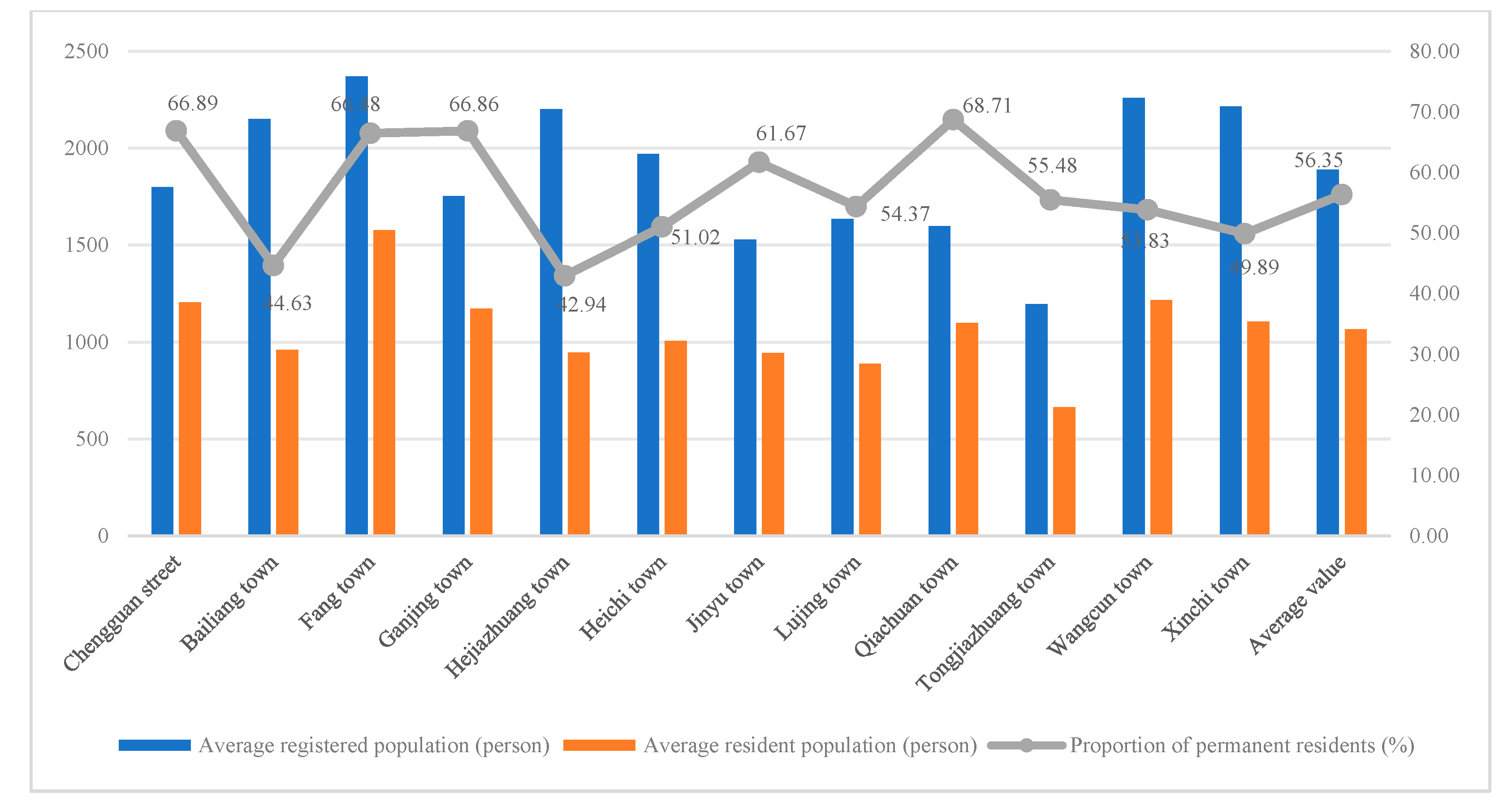
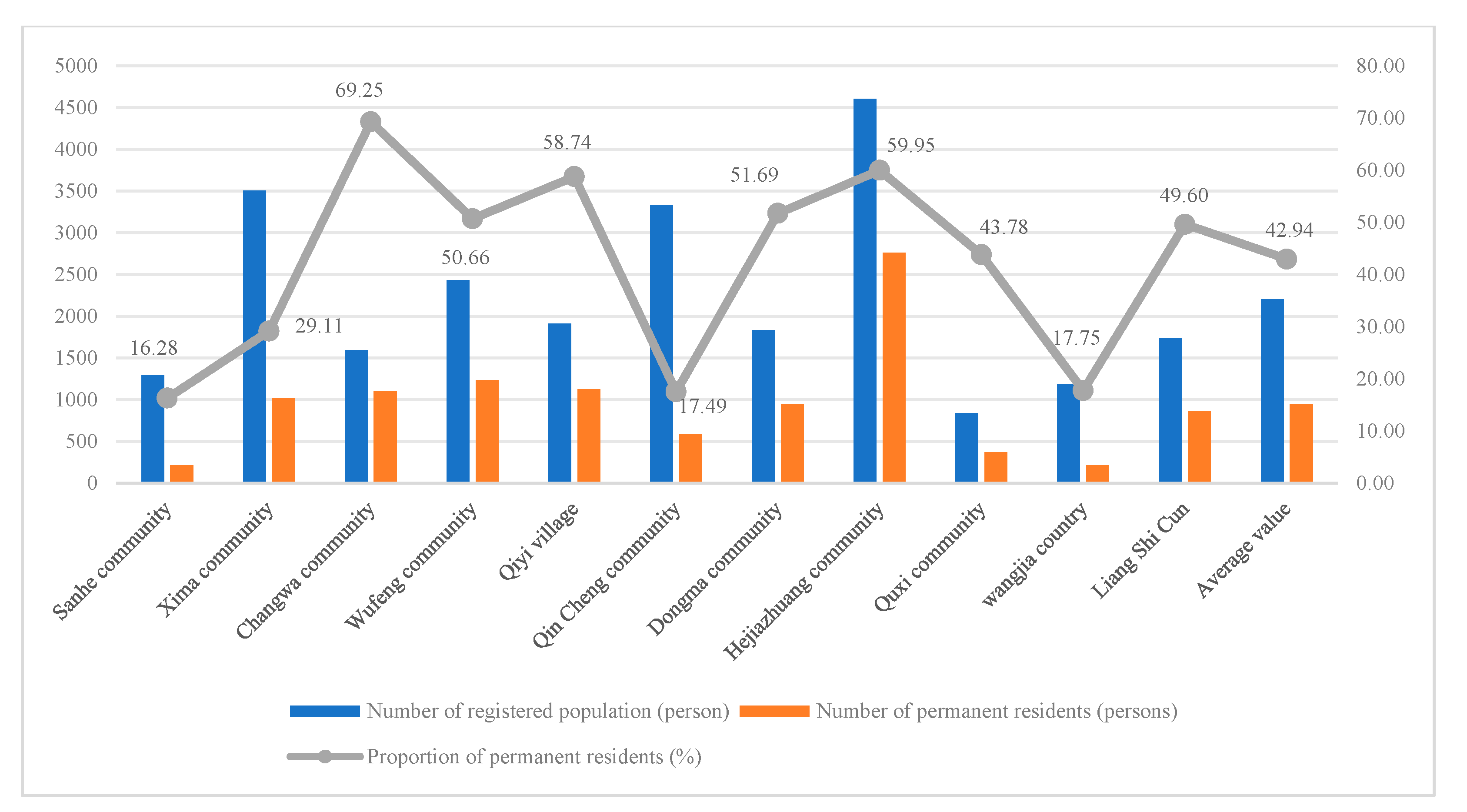
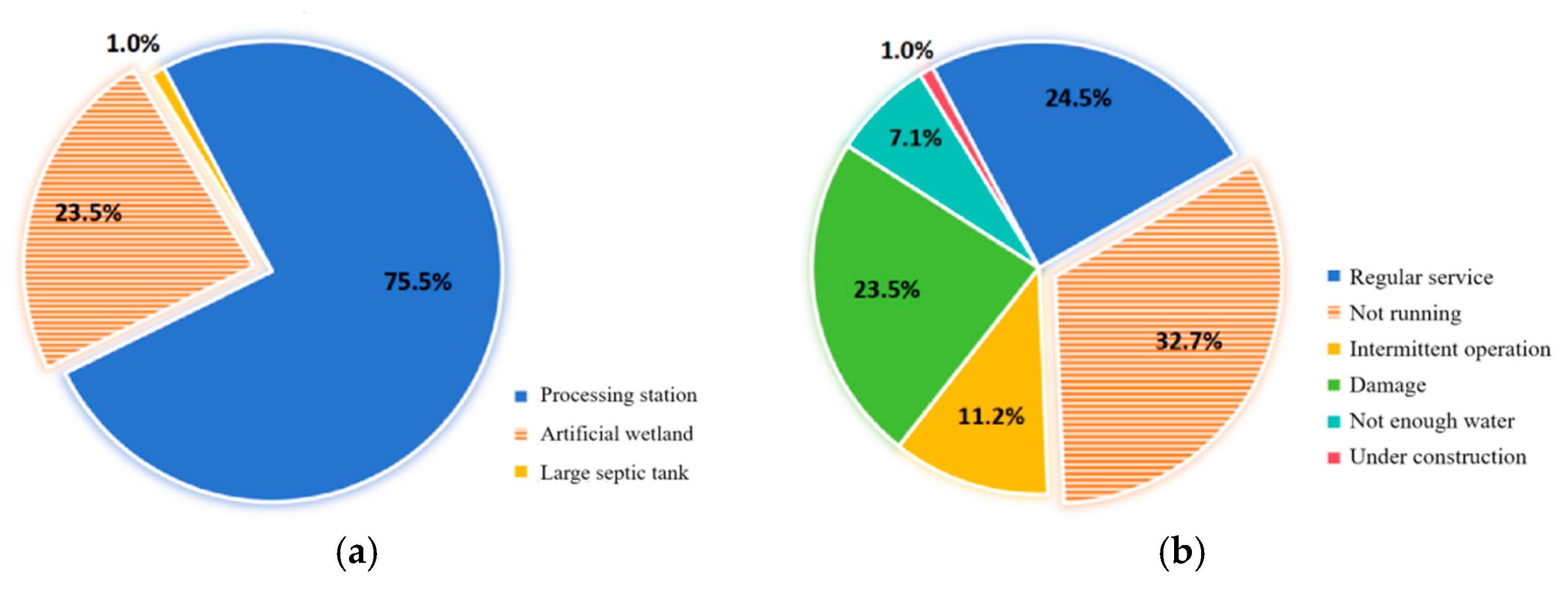




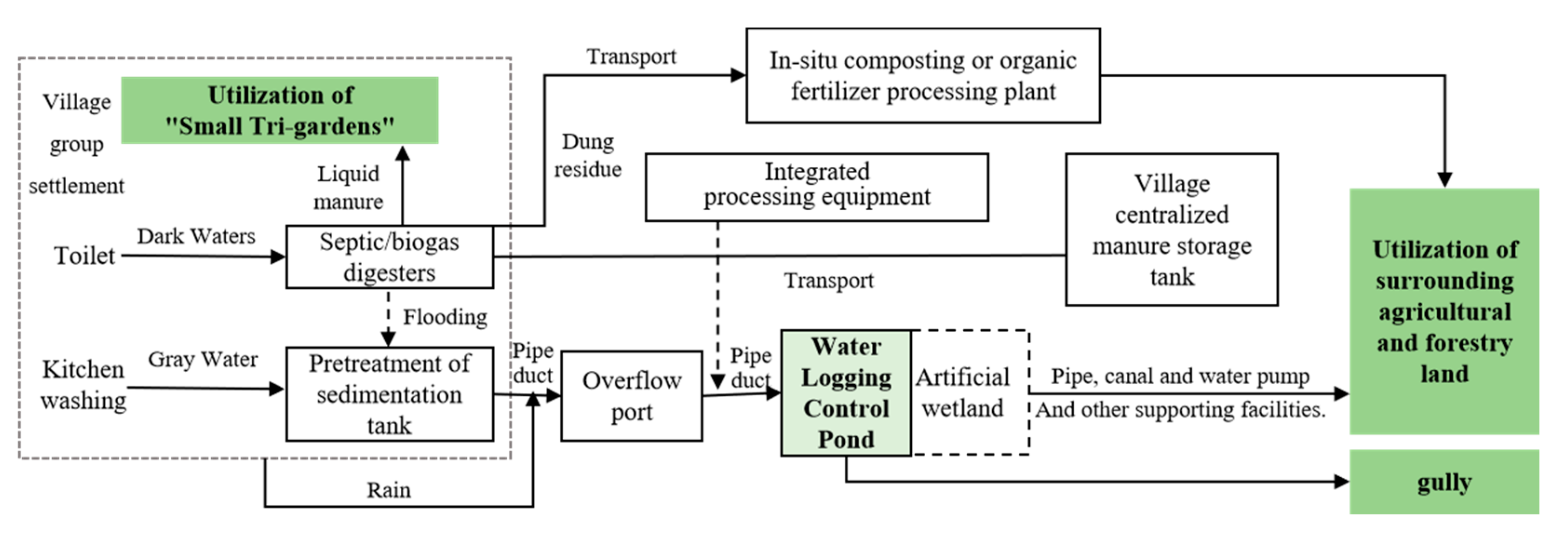
| B | Standard Error | Wald | Freedom | Significance | Exp(B) | 95% Confidence Interval of EXP(B) | |||
|---|---|---|---|---|---|---|---|---|---|
| Lower Limit | Upper Limit | ||||||||
| Step 1 a | PSI | −0.067 | 0.043 | 2.363 | 1 | 0.124 | 0.936 | 0.860 | 0.918 |
| Floor area (m2) | −0.004 | 0.003 | 1.139 | 1 | 0.286 | 0.996 | 0.990 | 1.003 | |
| Source of operating funds | 0 | 0 | 2.871 | 2 | 0.238 | 0 | 0 | 0 | |
| Source of operating funds (1) | 3.909 | 2.365 | 2.731 | 1 | 0.098 | 49.857 | 0.483 | 5143.224 | |
| Source of operating funds (2) | 6.358 | 7.519 | 0.715 | 1 | 0.398 | 577.012 | 0.000 | 1,449,834,550.564 | |
| Handling ability | 0.078 | 0.068 | 1.310 | 1 | 0.252 | 1.081 | 0.946 | 1.235 | |
| Treatment process | 0 | 0 | 1.644 | 3 | 0.649 | 0 | 0 | 0 | |
| Treatment process (1) | −8.850 | 8.525 | 1.078 | 1 | 0.299 | 0.000 | 0.000 | 2589.169 | |
| Treatment process (2) | −15.768 | 40,192.970 | 0.000 | 1 | 1.000 | 0.000 | 0.000 | 0 | |
| Treatment process (3) | −0.260 | 2.450 | 0.011 | 1 | 0.915 | 0.771 | 0.006 | 93.855 | |
| Constant | −0.021 | 2.435 | 0.000 | 1 | 0.993 | 0.979 | 0 | 0 | |
| Front, Middle, and Backyard Type | Anterior and Posterior Courtyard Type | Anterior and Posterior Courtyard Type | Front-Yard Type | Street Type |
| Homestead area 10 × 30 = 300 m2 | Homestead area 10 × 32 = 320 m2 | Homestead area 11.4 × 33.2 = 378 m2 | Homestead area 12 × 32 = 384 m2 | Homestead area 11.5 × 23.5 = 270 m2 |
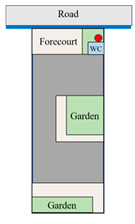 | 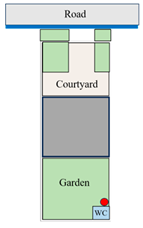 | 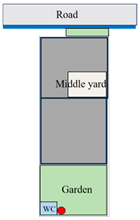 | 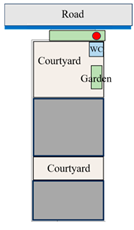 | 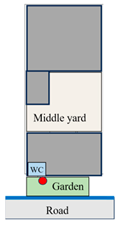 |
| Inhabitants: 3 people Small tri-gardens: 36 m2 | Inhabitants: 3 people Small tri-gardens: 86 m2 | Inhabitants: 4 people Small tri-gardens: 20 m2 | Inhabitants: 3 people Small tri-gardens: 62 m2 | Inhabitants: 4 people Small tri-gardens: 21.6 m2 |
| Qianzhongyuan type | Qianzhongyuan type | Anteriormiddle accessory type | Front-yard type | Surrounding type (mountainous area) |
| Homestead area 9.4 × 29.8 = 280 m2 | Homestead area 10 × 29.8 = 298 m2 | Homestead area 11 × 34 = 374 m2 | Homestead area 12 × 30 = 360 m2 | Homestead area 300 m2 |
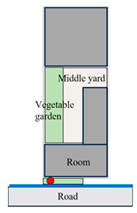 | 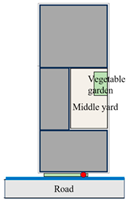 |  | 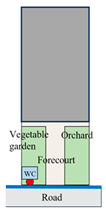 | 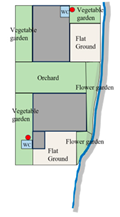 |
| Inhabitants: 4 people Small tri-gardens: 12 m2 | Inhabitants: 4 people Small tri-gardens: 5 m2 | Inhabitants: 4 people Small tri-gardens: 98 m2 | Inhabitants: 4 people Small tri-gardens: 120 m2 | Inhabitants: 3 people Small tri-gardens: >300 m2 |
Legend:  Toilet Toilet  Septic tank Septic tank  Small Tri-gardens Small Tri-gardens  Ditch Ditch  Road Road | ||||
| Transmission Mode | Trench Transmission | Pipeline Transmission |
|---|---|---|
| Advantages | The investment is low, generally CNY 0.6~12 thousand per household, which is convenient for construction and maintenance and has little influence on villagers. | It is easy to realize rain and sewage diversion, with low odor, a low leakage rate, a good thermal insulation effect, and basically no overflow pollution. |
| Disadvantages | The confluence of rain and sewage easily leaks and is easily influenced by the surrounding environment, with a high risk of overflow pollution, strong odor, and poor thermal insulation effect, which makes it impossible to operate in cold areas in winter. | The one-time investment is relatively high, about CNY 10,000~15,000 yuan per household. The broken road construction pipeline has a great impact on the villagers, and the later operation and maintenance costs are relatively high. |
| Applicable object | Hilly and mountainous areas with complex topography that are not conducive to the connection of pipe networks. | Flat plains and tablelands. |
Disclaimer/Publisher’s Note: The statements, opinions and data contained in all publications are solely those of the individual author(s) and contributor(s) and not of MDPI and/or the editor(s). MDPI and/or the editor(s) disclaim responsibility for any injury to people or property resulting from any ideas, methods, instructions or products referred to in the content. |
© 2025 by the authors. Licensee MDPI, Basel, Switzerland. This article is an open access article distributed under the terms and conditions of the Creative Commons Attribution (CC BY) license (https://creativecommons.org/licenses/by/4.0/).
Share and Cite
Huang, M.; Duan, D.; Tan, S.; Huang, L. Resource-Oriented Treatment Technologies for Rural Domestic Sewage in China Amidst Population Shrinkage: A Case Study of Heyang County in Guanzhong Region, Shaanxi Province. Buildings 2025, 15, 1417. https://doi.org/10.3390/buildings15091417
Huang M, Duan D, Tan S, Huang L. Resource-Oriented Treatment Technologies for Rural Domestic Sewage in China Amidst Population Shrinkage: A Case Study of Heyang County in Guanzhong Region, Shaanxi Province. Buildings. 2025; 15(9):1417. https://doi.org/10.3390/buildings15091417
Chicago/Turabian StyleHuang, Mei, Degang Duan, Sicheng Tan, and Ling Huang. 2025. "Resource-Oriented Treatment Technologies for Rural Domestic Sewage in China Amidst Population Shrinkage: A Case Study of Heyang County in Guanzhong Region, Shaanxi Province" Buildings 15, no. 9: 1417. https://doi.org/10.3390/buildings15091417
APA StyleHuang, M., Duan, D., Tan, S., & Huang, L. (2025). Resource-Oriented Treatment Technologies for Rural Domestic Sewage in China Amidst Population Shrinkage: A Case Study of Heyang County in Guanzhong Region, Shaanxi Province. Buildings, 15(9), 1417. https://doi.org/10.3390/buildings15091417







